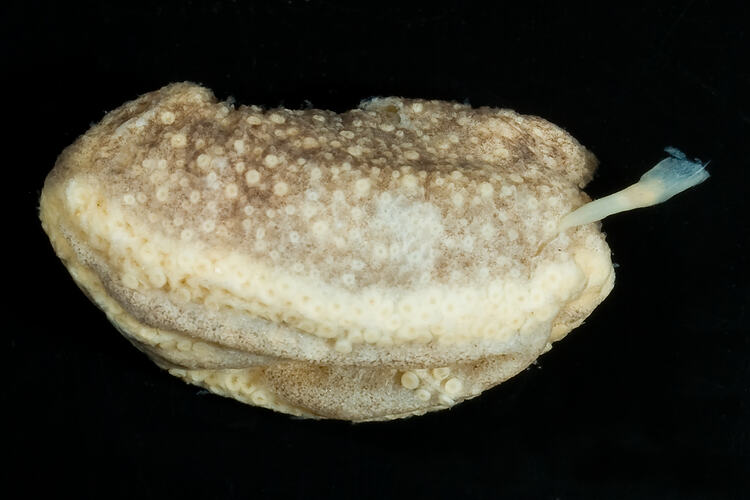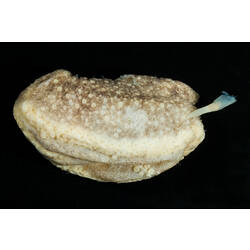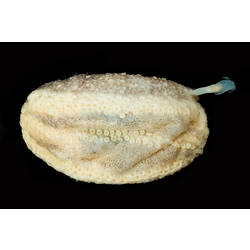General Description
Body stout, rounded dorsally with short upturned oral and anal ends and 5 anal teeth; distinct oval sole, wider than the body with upturned margin; body dark grey, created by brown flecking; 10 dendritic tentacles, ventral 2 smaller; thin, calcareous, crystalline body wall with small tube feet scattered dorsally and laterally and often covered with grit; ventral sole with radial tube feet (peripheral and mid-ventral); body wall ossicles multi-layered knobbed, perforated plates (non-imbricating), knobbed cups, and lumpy or smooth buttons; sole ossicles cups, elongate plates, buttons; up to ~20 mm long (tentacles extended), 7 mm wide, and 6 mm high. Apsolidium handrecki is distinguished from Apsolidium densum by colour (dark grey not white), thinner body wall, ventral sole that is wider than the width of the body, and various ossicle characteristics.
Biology
The sexes of Apsolidium handrecki are known to be separate and a gonopore can be seen between tentacle trunks. Its crystalline body wall is often covered with grit and detritus, held in place by a covering of small dorsal and lateral tube feet. Apsolidium handrecki uses its ventral tube feet to adhere to the tops and sides of rocks in shallow water, where it feeds by extending branching, tree-like tentacles into the surrounding water to collect organic particles.
Distribution
Southern Australia, including Victoria and SW Western Australia
Habitat
Reefs/Coastal shores. Under surface of rocks, often covered with detritus. From 0-3 m depth.
More Information
-
Animal Type
-
Animal SubType
-
Fast Fact
This species was named in honour of the late Clarrie Handreck, who collected this species and contributed greatly to our understanding of Victorian marine invertebrates through his voluntary field and collection-based work with the Marine Research Group of the Field Naturalists Club of Victoria and Museums Victoria.
-
Brief Id
Small with short upturned oral and anal extensions and distinct sole, dark grey (brown flecking), body wall thin and calcareous with scattered tube feet, 10 dendritic tentacles.
-
Maximum Size
2 cm
-
Habitats
-
Diet
Organic matter
-
Endemicity
-
Conservation Statuses
CITES: Not listed, FFG Threatened List: Endangered, EPBC Act 1999: Not listed, IUCN Red List: Not listed
-
Depths
Shore (0-1 m), Shallow (1-30 m)
-
Water Column Locations
On or near seafloor
-
Taxon Name
-
Scientific Author
O'Loughlin & O'Hara, 1992
-
Common Name
Sea Cucumber
-
Phylum
-
Class
-
Order
-
Family
-
Genus
-
Species Name
handrecki



